The report so far has only focused on Regular Represented and Regular Non-represented employees because they make up the majority of the workforce (about 80%). Further, the majority of statistically significant results were for Regular employees.
Definitions of Employee Types:
- Regular employees: Employees in on-going, budgeted positions. Regular employees may be represented by a Bargaining Labor Union (e.g., AFSCME Local 88, Oregon Nurses Association, Corrections Deputy Association), or Non-represented.
- Limited Duration employees: Hired from outside the County into a limited duration position for up to two years. Limited Duration employees constituted about 3% of the County workforce in FY 2022.
- Temporary employees: Hired from outside the County to meet short-term, non-recurring, or emergency County work needs. Temporary employees typically work at least 20 hours per week, for up to 1,040 hours (6 months), with a potential extension to 2,080 hours (one year). Temporary employees constituted about 2% of the County workforce in FY 2022.On-Call employees: Hired from outside the County to meet intermittent, irregular, or less-than-half-time County work needs. On-Call employees constituted about 7% of the County workforce in FY 2022.
- Seasonal employees: Hired for a short amount of time to support a seasonal effort, such as an election. Seasonal employees constituted about 3% of the County workforce in FY 2022.
- Interns: Employees who are often students or trainees who are gaining work experience, sometimes to satisfy requirements for a qualification (e.g., legal interns in the District Attorney’s Office) or are participating in the College to County Internship program. Interns constituted about 2% of the County workforce in FY 2022.
Limited Duration, Temporary, On-Call, Intern, and Seasonal positions are all temporary in nature, meaning that they are not budgeted with ongoing funds and the positions will end after a certain period of time. Therefore, separations for these employee types are normal and expected.
The data used in this report are not tied to financial, budgetary, or funding source data. Therefore, it is beyond the scope of this project to answer questions related to positions funded with certain sources (e.g., the Coronavirus Aid, Relief, and Economic Security (CARES) Act or the American Rescue Plan (ARP) Act, both of which provided funding during the COVID-19 pandemic).
This section looks at the separation and hire rates of Limited Duration, Temporary, On-Call, Interns, and Seasonal employees. Please see the separation and hires dashboards for more information. Other employment movement actions like promotions and reclassifications were not included in analyses because those actions are either very infrequent or are not possible for these types of employees.
Limited Duration Employees
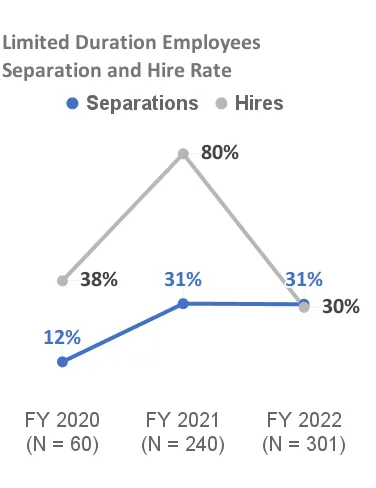
In FY 2020, the hiring rate of Limited Duration employees was 32%. It then saw a dramatic and statistically significant increase to 80% in FY 2021, then a statistically significantly drop down to 30% in FY 2022. This peak in Limited Duration hires in FY 2021 may reflect the increase in hiring into positions that temporarily supported the County’s COVID-19 response.
There was also a statistically significant increase in the separation rate of Limited Duration employees from 12% in FY 2020 to 31% in FY 2021, then held steady at 30% in FY 2022.
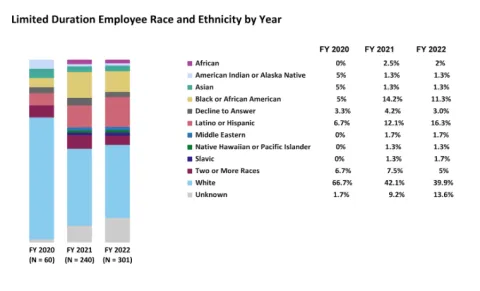
In FY 2020, the majority of Limited Duration employees were White (66.7%). In FY 2021 and FY 2022, the percentage of Limited Duration employees identifying as White decreased to below 45%. In contrast, the proportion of Limited Duration employees identifying as Latino or Hispanic rose between FY 2020 and FY 2022: from 6.7% to 12.1%, then to 16.3%.
Limited Duration employees sometimes move into Regular positions or the Limited Duration position is converted to an ongoing Regular position. Unfortunately, we did not have a way of tracking those movements with the data in this report.
Temporary Employees
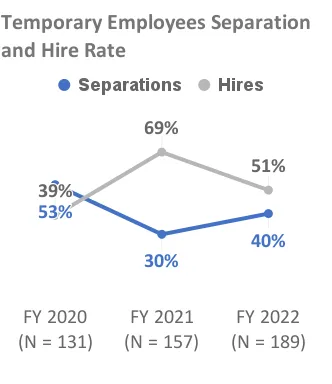
Somewhat similar to the patterns we see for Limited Duration employees, the hiring rate for Temporary employees was 39% in FY 2020, which then saw a notable and statistically significant increase to 69% in FY 2021, followed by a statistically significantly decrease to 51% in FY 2022. The peak in Temporary hires in FY 2021 may reflect the increase in hiring into positions that temporarily supported the County’s COVID-19 response.
The overall separation rate for Temporary employees statistically significantly decreased from 53% in FY 2020 to 30% in FY 2021, and then statistically significantly rose to 40% in FY 2022.
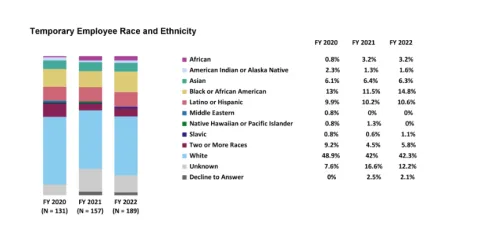
Between FY 2020 and FY 2022, less than half of Temporary employees identified as White. In FY 2020, the proportion of Temporary employees who identified as Black or African American was 13.0%, which slightly decreased to 11.5% in FY 2021 and then increased to 14.8% in FY 2022. In FY 2020, the percentage of Temporary employees who identified as Two or More Races was 9.2%, decreasing to 4.5% in FY 2021 and then slightly increasing to 5.8% in FY 2022.
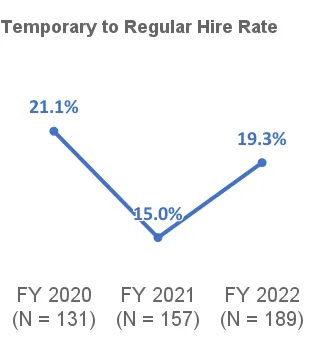
Temporary employees sometimes move into ongoing, Regular positions. The Temporary-to-Regular employee hire rate was 21.1% in FY 2020, 15.0% in FY 2021, and 19.3% in FY 2022. There were no statistically significant trends in this rate across race and ethnicity groups.
On-Call Employees
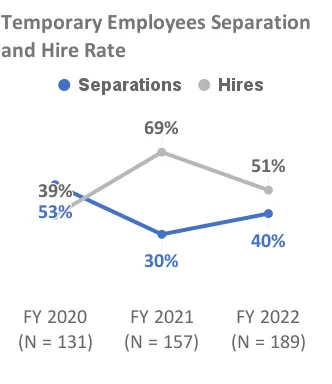
The hire rate for On-Call employees statistically significantly decreased between FY 2020 and FY 2021, from 34% to 18%. It then saw a statistically significant increase to 22% in FY 2022.
On the other hand, the separation rate for On-Call employees steadily increased, from 25% in FY 2020 to 31% in FY 2021, to 36% in FY 2022. This rise in separations is likely related to the high On-Call hire rate in FY 2020, which may have been necessitated by the emergence of COVID-19 toward the end of FY 2020.
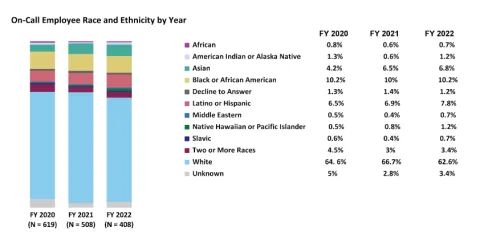
The majority of On-Call employees, approximately two-thirds, identified as White between FY 2020 and FY 2022. In FY 2020, the percentage of On-Call employees that identified as Asian was 4.2%, which then saw a statistically significant increase to approximately 6.5% in FY 2021, then held steady in FY 2022 at 6.8%.

On-Call employees sometimes move into ongoing, Regular positions. The hire rate of employees moving from On-Call to Regular positions was 3.3% in FY 2020 and 2.2% in FY 2021. In FY 2022, the On-Call to Regular Employee hire rate statistically significantly increased to 4.9%. There were no significant trends in this rate across race and ethnicity groups.
Interns
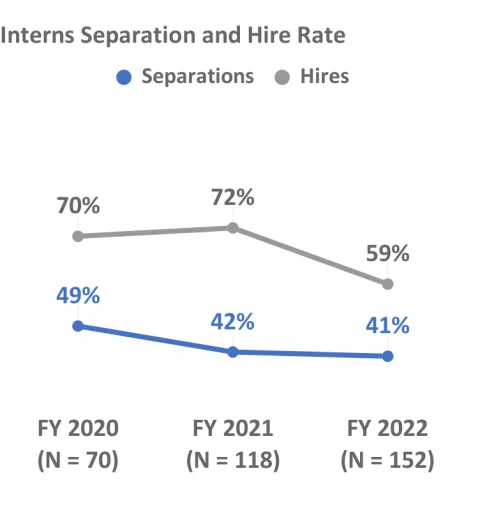
As part of the Workforce Equity Strategic Plan (WESP), there has been a countywide effort to increase school-to-work and community-to-work pipelines for people from racially and economically disadvantaged communities. A key strategy to meet this goal has been to increase resources for the College to County program, which hosts college students from historically underrepresented communities with paid summer internships at the County. We examined hiring and separation rates of Intern employees, many of whom were College to County interns. There were also interns in other internship programs, such as legal interns in the District Attorney’s Office.
The hire rate for interns decreased from 70% in FY 2020 and 72% in FY 2021, to 59% in FY 2022. It is notable, however, that the number of Interns almost doubled over the reporting period: from 46 interns in FY 2020 to 89 interns in FY 2022.
The separation rate for Interns was 49% in FY 2020, which slightly decreased to 42% in FY 2021 and 41% in FY 2022.
Interns sometimes move into Regular positions. Unfortunately, we did not have a way of tracking those movements with the data in this report.
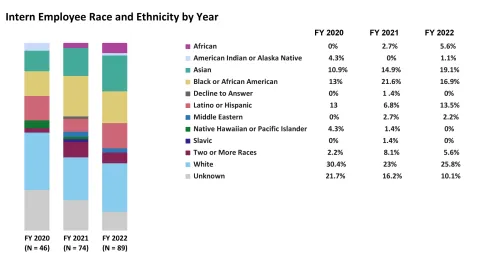
Interns are the most diverse employee type with regard to the Race and Ethnicity category. In FY 2020, the percentage of Interns who identified as White was 30.4%. This decreased to 23.0% in FY 2021 and increased slightly to 25.8% in FY 2022. The percentage of Interns who identified as Asian in FY 2020 was 10.9%, which increased to 14.9% in FY 2021 and 19.1% in FY 2022. The percentage of Interns who identified as Black or African American increased from 13.0% in FY 2020 to 21.6% in FY 2021 and decreased in FY 2022 to 16.9%, while the percentage of Latino or Hispanic Interns dropped from 13.0% in FY 2020 to 6.8% in FY 2021, but increased to 13.5% in FY 2022.
Seasonal Employees
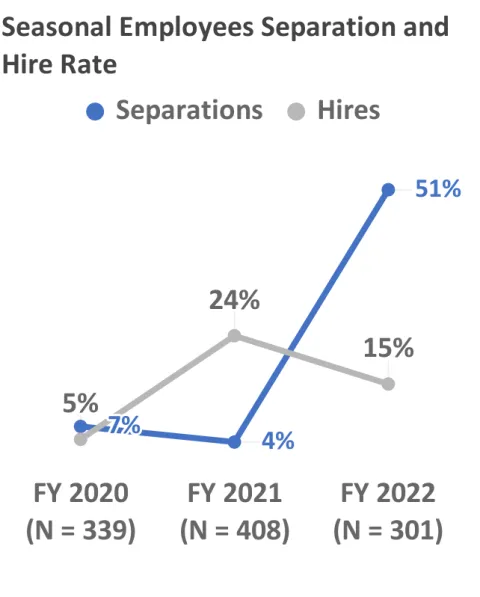
Seasonal employees are primarily hired in the Department of Community Services Elections Division to support seasonal elections. We can see this hiring pattern reflected in the significant increase in the hire rate for Seasonal employees, from 5% in FY 2020 to 24% in FY 2021. This hiring increase in FY 2021 was due to the support needed for the November 2020 General Election.
The separation rate for Seasonal employees was low in FY 2020 (7%) and FY 2021 (4%), then dramatically and statistically significantly increased to 51% in FY 2022, which reflects the seasonal nature of these positions, as well as impacts of the COVID-19 pandemic on the workforce, including employees deciding not to return to seasonal positions.
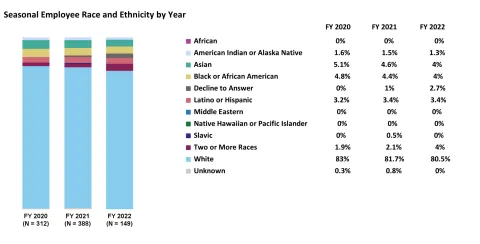
The majority of Seasonal employees (around 80%) identified as White each fiscal year between FY 2020 and FY 2022.
Go to the next section: More Information
